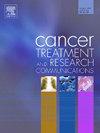Diagnostic performance of digital breast tomosynthesis (DBT) versus digital mammography (DM) in a population clinically referred for breast imaging – a retrospective cohort study
Q3 Medicine
引用次数: 0
Abstract
Purpose
To compare the performance of Digital Breast Tomosynthesis (DBT) with Digital Mammography (DM) in patients clinically referred for breast imaging.
Methods
Diagnostic performance of DBT (in 2016, after transition to DBT) was compared with DM (in 2011, before the transition) in consecutively referred patients (N = 10,742 exams). Reference standard was outcomes from all tests including histopathology and clinical review within the same year. Primary outcome was area under receiver operating characteristic curve (AUC-ROC).
Results
Cancer rates did not differ between DBT (1.72 % (CI 1.38–2.15 %)) and DM (1.71 % (CI 1.40–2.08 %)). AUC-ROC was similar for DBT (0.91 (CI 0.87–0.95)) and DM (CI 0.91 (0.88–0.95)). Abnormal interpretation rate for DBT was 2.83 % (CI 2.38–3.36 %) and for DM it was 2.17 % (CI 1.82–2.58 %), and the biopsy rate for DBT was 8.2 % (CI 7.4–9.0 %) and for DM it was 9.9 % (CI 9.1–10.6 %)).
In patients with dense breasts (vs overall cohort) AUC-ROC and sensitivity were lower for both DM and DBT. Within this subgroup, AUC-ROC for DBT was 0.90 (CI 0.84–0.95) and for DM it was 0.85 (CI 0.79–0.92), sensitivity was 78.2 % (CI 65.0–88.2 %) for DBT and 64.8 % (CI 50.6–77.3 %) for DM, and ultrasound was accurate whether it was used with DBT (AUC-ROC 0.95 (CI 0.91 – 0.99)) or DM (AUC-ROC 0.95 (CI 0.90 – 0.99))
Conclusion
In clinically referred patients, diagnostic accuracy and diagnostic yield were similar between DBT and DM. DBT may have a higher abnormal interpretation rate but a lower biopsy rate. DBT may be more accurate than DM in dense breasts.
求助全文
约1分钟内获得全文
求助全文
来源期刊

Cancer treatment and research communications
Medicine-Oncology
CiteScore
4.30
自引率
0.00%
发文量
148
审稿时长
56 days
期刊介绍:
Cancer Treatment and Research Communications is an international peer-reviewed publication dedicated to providing comprehensive basic, translational, and clinical oncology research. The journal is devoted to articles on detection, diagnosis, prevention, policy, and treatment of cancer and provides a global forum for the nurturing and development of future generations of oncology scientists. Cancer Treatment and Research Communications publishes comprehensive reviews and original studies describing various aspects of basic through clinical research of all tumor types. The journal also accepts clinical studies in oncology, with an emphasis on prospective early phase clinical trials. Specific areas of interest include basic, translational, and clinical research and mechanistic approaches; cancer biology; molecular carcinogenesis; genetics and genomics; stem cell and developmental biology; immunology; molecular and cellular oncology; systems biology; drug sensitivity and resistance; gene and antisense therapy; pathology, markers, and prognostic indicators; chemoprevention strategies; multimodality therapy; cancer policy; and integration of various approaches. Our mission is to be the premier source of relevant information through promoting excellence in research and facilitating the timely translation of that science to health care and clinical practice.
 求助内容:
求助内容: 应助结果提醒方式:
应助结果提醒方式:


